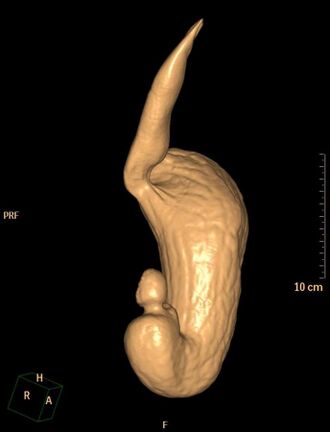Medicine:CT Gastrography
From HandWiki
| CT Gastrography | |
|---|---|
| Medical diagnostics | |
 Normal CT Virtual gastroscopy | |
| Purpose | is noninvasive procedure for detection of gastric abnormalities |
Computed tomographic (CT) gastrography, also called virtual gastroscopy (VG), is a noninvasive procedure for the detection of gastric abnormalities. Multiple X-rays are used to create a 3-Dimensional image of the organ, allowing abnormalities to be detected.[1]
Advantages
- rapid and noninvasive
- identifies local tumor invasion, lymph node and metastasis in cases of gastric cancer
Indications
- early detection of gastric carcinoma
- to examine gastric abnormalities, e.g. hiatus hernia, polyps and ulcers
- post-surgical assessment of the stomach
Technique
- Patient fasts at least 8 hours before the exam.
- Bowel distension, optimal gastric distention is a fundamental prerequisite for CT gastrography data evaluation; collapsed gastric wall may mimic disease or obscure underlying pathology.
- Negative oral contrast medium with effervescent granules is effective for optimal gastric distension.
Data acquisition and analysis
- CT scanning is ideally performed on a multi-detector computed tomography (MDCT) with a thin collimation.
- Data interpretation with the use of two-dimensional (2D) and three-dimensional (3D) displays for proper evaluation
See also
- CT examinations
References
 |

